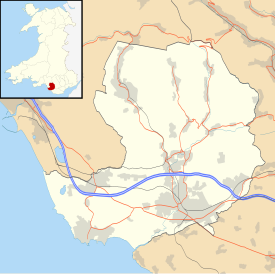St Crallo's Church
| St Crallo's Church | |
|---|---|

St Crallo's Church
|
|
|
Location in Bridgend County Borough
|
|
| Coordinates: 51°30′02″N 3°31′59″W / 51.500518°N 3.532983°W | |
| OS grid reference | SS 936 790 |
| Location | Coychurch, Bridgend |
| Country | Wales, United Kingdom |
| Denomination | Church in Wales |
| History | |
| Founded | 13th century |
| Dedication | Saint Crallo |
| Architecture | |
| Heritage designation | Grade I |
| Architectural type | Church |
| Style | Medieval |
St Crallo's Church, often referred to historically as The Cathedral of the Vale of Glamorgan, is a Grade I listed church in Coychurch Lower, Bridgend County Borough, southern Wales.
The church is dedicated to the 6th century Celtic saint, Crallo, supposedly related to both Saint Illtyd and Saint Canna. The village in which the church is situated, Coychurch is known in the Welsh language as Llangrallo; Llan – Church, Grallo – Crallo, the church of Crallo. It is believed that the saint founded a church on the site before the construction of the present medieval building.
The present church is dated to the mid to late 13th century, when it was built as part of St Crallo's College. The church had undergone no changes since it was built until John Prichard began a restoration in 1870. At the time of the restoration, no work was done on the tower because it appeared to be sound and there was a lack of funds for further restoration work.
On 7 February 1877, the tower fell without warning. The south transept of the church was in ruins and the northern transept was badly damaged. The tower's collapse also damaged the cross of Saint Crallo in the church courtyard. In 1888, the church hoped to be able to restore the Saint Crallo cross with the help of a drawing made by F. R Kempson. Fragments of the cross were carefully preserved. The cross was reassembled and is now kept inside the church. At the time the tower fell, a contractor had been removing the remains of those who had been buried near the tower. Some 1,800 remains were being moved to the east side of the church.
Since the nave had relatively little damage, a temporary wall was built at its east end to allow the church to conduct services. It remained in this condition until the church was able to fund the rebuilding project. F. R. Kempson was given the responsibility of the rebuilding work in 1888. The stained glass windows of the aisle were installed by Celtic Studios in the mid 20th century, while the western windows of engraved glass were added by Frank Roper in 1963.
Newman describes the St Crallo's as 'large and impressive' while E. A. Freeman, writing in 1857, suggested that the building would make 'an admirable model for small colonial church'. Built in the mid to late 13th century St Crallo's is cruciform in design.
...
Wikipedia

